Dear readers,
Our economy is not sustainable the way it currently works. We slowly destroy our planet by polluting and depleting the earth of its natural resources. We waste massive amounts of water to sustain meat production, we deplete our soil with traditional methods of agriculture, and destroy entire forests to replace them with mono-cultures, just for short term economic gains which benefit the rich.
Regular people like you and me have to choose between eating affordably or eating healthy, as organic food comes at a price not everyone can afford. Those who can’t, are reduced to eating veggies sprayed with pesticides. Having to decide between my health or my pocket is not a choice I intend to make for myself. I choose both.
Growing our own food
The only solution I can come up with to counter this issue is to start growing my own fruits and vegetables, and be as independent as possible from the big food industry. Giving up meat and dairy was also part of this process.
I live in a tropical country, and many things here grow very easily.
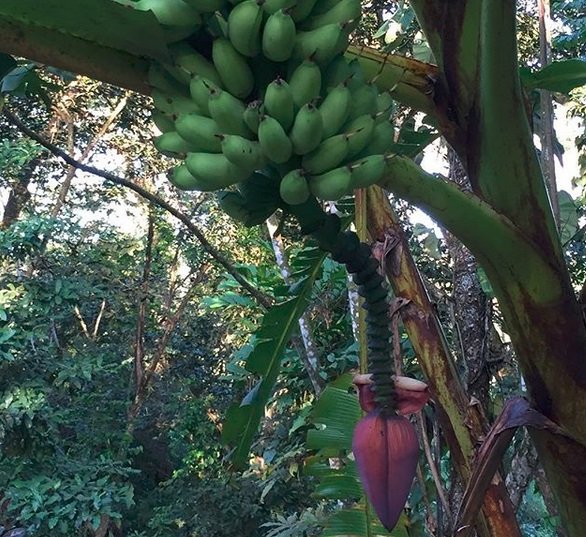
Bananas grow wild here, yet people still buy bananas in supermarkets instead of growing their own
The local fruits that I can grow here include papaya, banana, plantain, mango, avocado, water melon, cantaloupe, and citrus (oranges, lemons, limes and grapefruit).
Veggies that I was thinking about growing include cucumber, spinach, zucchini, sweet potato, squash, pumpkin, tomato and peppers.
Finally, herbs like basil, rosemary, oregano and lemon grass, as well as roots such as ginger and turmeric also grow very easily here in Panama.
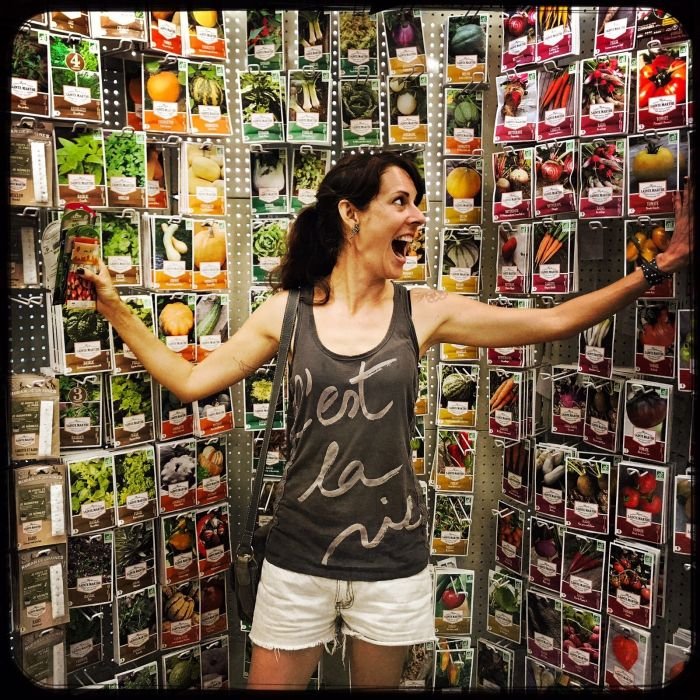
every time I can, I buy seeds of plants I don't yet have in my garden
Before I go on, I have to let you know that I’m no expert in this, but one can learn anything, right? So I started reading about permaculture.
The three core tenets of permaculture are:
- Care for the earth: Don’t harm the environment
- Care for the people: Provision for people to access those resources necessary for their existence
- Setting limits to population and consumption: By governing our own needs, we can set resources aside to further the above principles. This includes returning waste back into the system to recycle into usefulness.The third ethic is sometimes referred to as Fair Share, which reflects that each of us should take no more than what we need before we reinvest the surplus. source
Why permaculture?
What I like the most about permaculture compared to traditional food growing methods is that it is sustainable. It encourages the use of recycled materials or trash that we all have in our home (also known as upcycling), as opposed to buying new building materials for your garden. Here is an example of recycled plastic bottles used to grow tomatoes upside-down.
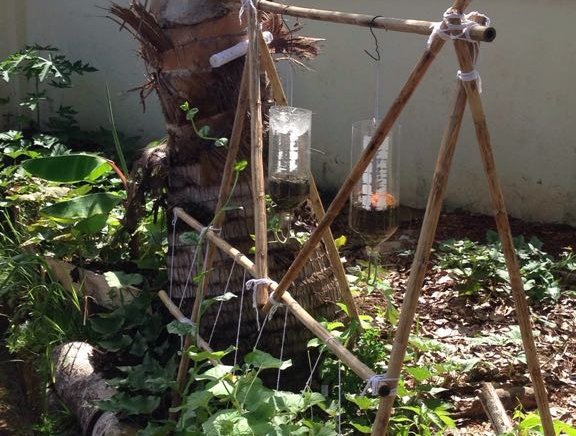
Moreover, In permaculture one uses garden designs based on patterns observed in nature. If nature works flawlessly (I’m referring to the harmony between plants, insects, soil etc) it makes sense to mimic these natural systems that are already in place.
So to rephrase the above: We can all create small gardens by recycling our own waste, thereby decreasing the amount of trash we produce. Moreover, if we grow our own food we reduce our consumption and consequently our carbon footprint, all while saving money!
Finally, I don’t think I need to stress the obvious health benefits and satisfaction of eating a completely organic fruit that you have grown yourself. Knowing where your food comes from nowadays is a luxury, provided that it is almost impossible to trust the information on food labels in supermarkets.
I will now take you through the steps that I took to start growing my own food at home. In order to do this, you don’t need to have a lot of space, and everything you will see in the following pictures can be done on a much smaller scale.
Making your own compost to feed your soil
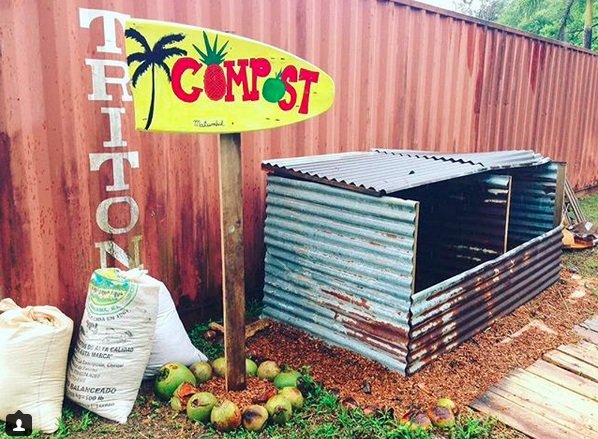
I've created 2 sections: one for compost that is almost finished, and the other where I pile up new organic waste. Eventually I transfer the bottom layer to the "almost ready" pile which I use in my garden.
Many people confuse soil with compost, but they are 2 very different things. Soil is the upper layer of the earth, and is composed of minerals, clay, rock particles and organic matter. Compost is the organic matter which provides the nutrients to your soil. Depending on what kind of soil you have in your region, you will need more or less compost.
Unlike the saying “less is more”, in this case more is better. The soil in my region is very compact clay, which makes it difficult for little plants to form roots and thrive. A compost layer over clay soil will attract earthworms who feed on compost, and these worms will make the soil looser. They also produce great compost of their own with their poop.
As I stated before, permaculture principles encourage us to use our own waste as opposed to buying fertilizers (even natural ones!). You’d be surprised all the things you can find in your house and outside in your yard, in parks, or on the side of the road in order to make high quality compost. Nature provides us with everything we need.
Composting can seem like a difficult science, but it basically is just the decomposition of organic matter. In order to decompose as fast as possible, you need to mix the following elements:
- Carbon (or browns), which include dead leaves, wood chips, cardboard or paper, straw
- Nitrogen (or greens), such as uncooked food scraps from fruits or veggies, fresh grass clippings or green leaves, coffee grounds
- Air and water. It’s the microbes that will do the decomposing of your compost pile, but only if they have access to air and moisture. Every once in awhile you'll need to turn over your compost pile to allow the microbes access to air and make sure there is enough moisture on your pile for them to do their work.
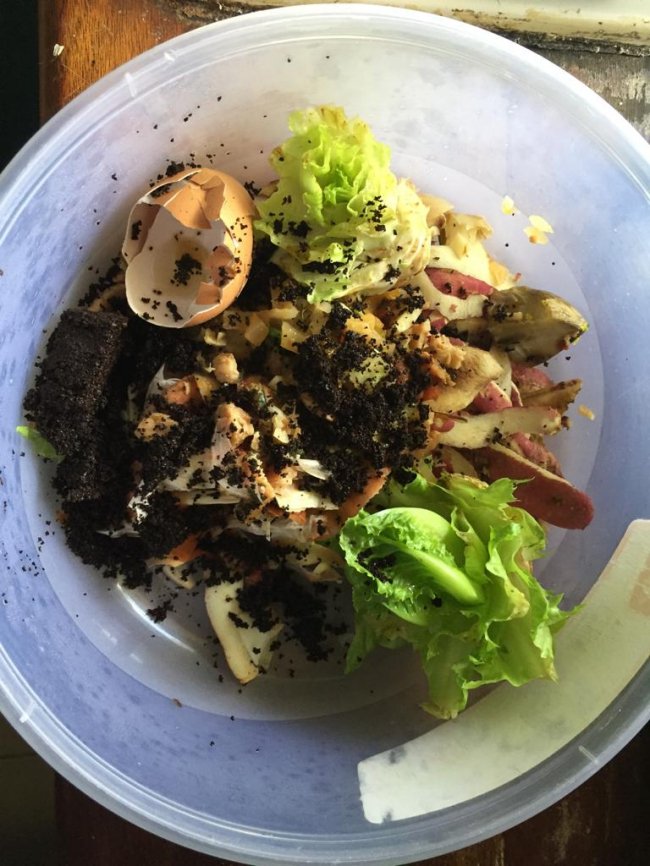
Typical kitchen food scraps for composting
IMPORTANT: Do not add anything that has been cooked, especially no meat or bone scraps. These will make your pile smelly and attract flies and maggots, which is not something you want to have in your compost. Your compost should be something that you’re not afraid to touch with your bare hands. It’s not gross, and it should not smell bad.
Other things to avoid putting is cat and dog poop, glossy color paper, tea bags that are not from natural fiber, and wood chips from treated wood (you don’t want to eat these chemicals!).
There are other types of composting, but this is the method I’m using in my home.
Composting can take anywhere between 3 weeks to several months, depending on the climate which you live in and the level of humidity. In cold temperatures it will obviously take longer. I’m lucky, as here we have average temperatures of about 28 degrees celcius with high humidity levels, making the process speedy. If you find that it takes too long, maybe you‘ll need to add moisture and nitrogen. If it’s too smelly and wet, you may have to add more browns.
How do you know if your compost is ready?
If it looks like dark soil, it’s ready! Check the picture below.
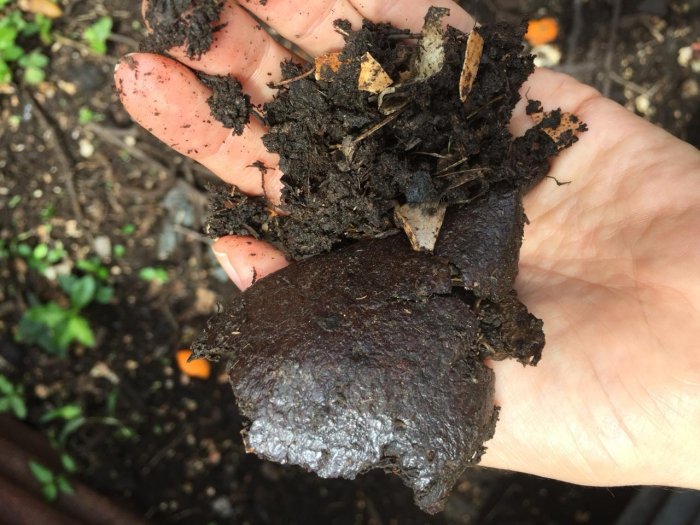
Growing mediums
I’m growing food in containers and in garden beds.
First, I experimented with containers on my balcony because it’s easier and more manageable (also less work!), and I was quite successful with it. You can see a short video of what I’m growing on my balcony here:
I noticed that growing cucumbers was extremely easy, and had fresh cucumbers, almost daily. Melons also grow quite easily, and remarkably fast! In about 2-3 weeks you start getting fruit.
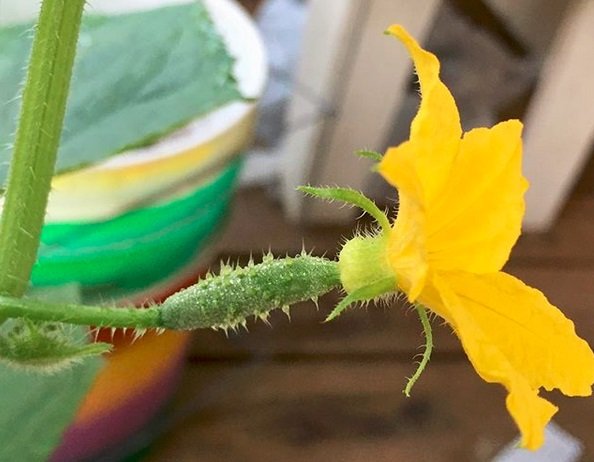
Flower that transforms into a cucumber when pollinated
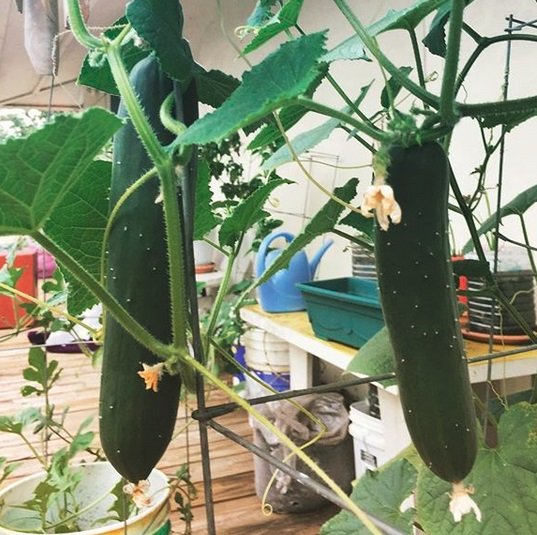
almost ready
Pollination is no issue in my region, as we have plenty of insects here in the jungle to make sure that the flowers of my cucumbers and melons are pollinated.
The one plant I do have difficulties with is zucchini. I’ve tried growing yellow and green zucchini, and even though the plant itself grows quite quickly, the plants struggle with mold and don’t really produce any fruit. It’s an issue I’m not yet able to resolve, and since nutrients are not the issue, I’m thinking that it must be the climate. If you have any ideas or solutions, I’m all ears!
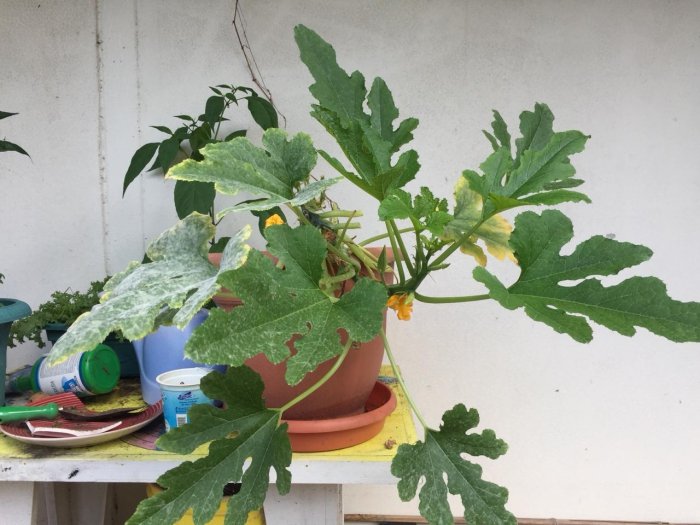
All my zucchini plants become sick and don't produce fruit
I’m also growing plenty of fruit trees on my balcony, which I will eventually transplant into the garden when they can’t grow any taller.

These fruit trees include orange trees, lemon trees and mango and are almost ready to be transplanted.
This blog post is already quite long, so I will conclude here for now. Please stay tuned for a next post in which I will show you how I prepared my garden beds, and grew my first plants in the garden. I will also write more about the successes and challenges I’ve encountered, and share some tips with you. As usual, I’m always happy to read your comments below =)


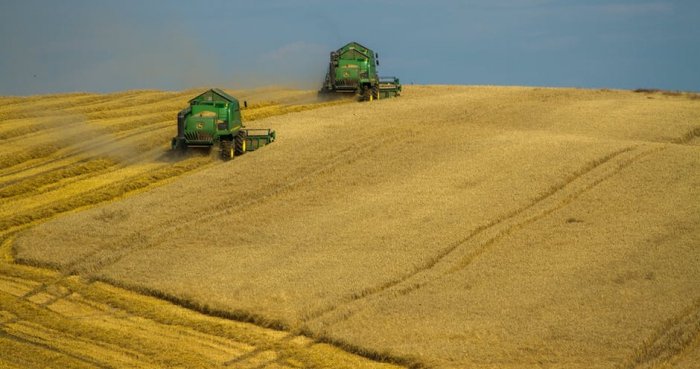
Awesome post Eve! And thanks for the video, you live in a fantastic place! So close to nature, so much greenery around, all those bird sounds... Reminded me of my Costa Rican adventure where I was staying in a wooden bunk almost in the jungle :)
Thank you so much @phortun! Yes, it's very similar to Costa Rica =). And the birds...sometimes I have to pause the video when I'm filming, and wait for them to shut up LOL. But I love it! Nature and no other people around is my idea of paradise
Same here! Too bad my fiancee is a citylife lover :D :(
Great stuff @evecab. I cant wait to get my own veg garden going. I don't want to start it in the house we are in as its just a rental and we are planning on leaving next year so I am hoping that once we get settled in our new home in a sunnier country we can grow loads of delicious produce!
Great job on the compost and indeed all the great looking fruits and veggies!
Thanks @moonunit! You will see it's so rewarding! I go out every day to look at the progress, it's quite addictive!
Hi, this post is amazing! Have you seen the Sndbox Homesteading Quest?
It is here, I think you will be interested, actually this post could be taken as the first part of the quest...
https://steemit.com/sndbox/@anomadsoul/sndbox-summer-camp-travel-food-and-homesteading-quest-or
oh damn, I hadn't seen this! But I think even if it qualifies for the first part, I won't have time to do the 3 other requirements by tomorrow unfortunately. What a shame! I will look out for the 2nd quest, and maybe I can participate in the next one instead.
Thanks for stopping by @anomadsoul, I'm glad you liked it =)
Its 3 parts. This could be the first one so just two to go. It is the only homesteading/Food Quest we´ll have, it would be awesome if you decide to finish it ^^
Read you around Eve!
Oh I see, I misunderstood! Ok I will try =)
I'm intrigued @evecab. I live in a country where people neglect agriculture a lot due to the abundance of crude oil. Well, not that the latter is even utilized properly. I have plans of venturing into agriculture one day to help boost the food supply here. Perhaps, I will have to start in my backyard as I've been motivated by you. Thanks.
You're welcome =). Let me know how it goes when you try!
Alright. I will keep you posted.
Damn, Eve! Great quick review of permaculture, didn't expect this from you!
The cucumber's unhealthy leaves must be plucked off immediately and burned to prevent further spreading of the disease. Don't compost or use them for mulch as the fungus can remain stagnant in soil for years.
You can help the plant with natural fungicide like neem oil, but I'm not in for those methods. For me all treatment must be integrated, in other words, serve more purposes than one.
Because of that, I think the best things to do are these two:
Protect the plant from temperature drops (the cold weakens it's immune system and stimulates the growth of the fungus) - temperatures must remain above 25C° to use this strategy.
Protect the plant from air moisture. This one is self-explanatory, the fungus loves water and it grows slower with less moisture.
Protect the plant from wind. Wind carries the spores and spreads the disease to other plants and leaf-to-leaf.
Stimulate the immune system of the plant. This can be done with quality compost, or my favorite and the most effective thing I've tried - aeriated compost tea! I'll make a post about it in a few months, you can Google it until then!
When you put togather the first 3 advices I gave you, a greenhouse just for the sensitive plants is a very good idea. Think about it...
With love,
@freegardens!
Thanks so much for the advice @freegardens! I will check out that aeriated compost tea, and cut off all the bad leaves. Number 2 is harder (how do you protect it from humidity?)
You're welcome, anything for you! ;)
It's just a general direction, you don't have to follow it all!
Obviously, you can't control air humidity without a greenhouse. You can't control the wind either and the temperature control would be silly (lighting a fire near the plant??)... All you can do is try to encourage the plant to build up it's immune system - which is enough to give you some cucumbers if you do it right, but the disease will eventually kill off the plant.
Jesus woman you make me want to move so badly. I love water melon and I'm so super jealous that you can grow it in your own back yard. I would love to read more posts like this :)
ahahah thanks @nicoleslife! You are welcome to visit anytime! i will definitely post more about this soon =)
I will definetly follow up on that offer ;)
Wow! Awesome post. Packed with tons of helpful information for beginners who want to get started on their own garden. Thanks, so much, for sharing.
Miss let me tell you that this post is incredible! It's really nice to know people that are thinking about our planet and what we are doing. This is very useful and I hope that your messages carry on growing in this social network. Thanks for this miss.
Kind of regards from Venezuela,
Manu Rodriguez
muchas gracias por tus lindas palabras Manu! =)
Jaja esto me ha pasado un par de veces, termino pensando que la persona es de habla inglesa y resulta que son hermanos Latinoamericanos, Gracias a ti por tu aporte! un abrazo.
Great job lady, how do you manage your time to do all these, I manage a poultry farm too but the stress is tough, like I said earlier you are an icon to look up to, thanks for blessing us with your knowledge . You are not just dishing out philosophy but practical knowledgeable example, having you here is a blessing. Bravo!!!
ahahhha thank you! To be honest, my days don't have enough hours in them sometimes. Gardening is something I usually do just for a bit at the end of the day or on the weekends. Once you''ve started, it just needs maintenance to pull out the weeds, and the fun part, collect what you've grown.
Thanks
This post is awesome! When I used to live with my Matriarch, Sundays were gardening day and we grew our own vegetables from leafy greens from the Camote plant to eggplants, okras and, squash.
My matriarch had a green thumb and could pretty much raise any kinds of vegetation.
I live in an apartment with no room to plant but agree with you on how our current food system is not feasible in the long run. I still like eating meat though so its hard for me to swear off cattle and hog farm.
yes it's hard in a small apartment. Although I saw this girl on YouTube who transformed entire apartment into a food forest, pretty cool stuff. I will look her up for you =)
Peace, Abundance, and Liberty Network (PALnet) Discord Channel. It's a completely public and open space to all members of the Steemit community who voluntarily choose to be there.Congratulations! This post has been upvoted from the communal account, @minnowsupport, by evecab from the Minnow Support Project. It's a witness project run by aggroed, ausbitbank, teamsteem, theprophet0, someguy123, neoxian, followbtcnews, and netuoso. The goal is to help Steemit grow by supporting Minnows. Please find us at the
If you would like to delegate to the Minnow Support Project you can do so by clicking on the following links: 50SP, 100SP, 250SP, 500SP, 1000SP, 5000SP.
Be sure to leave at least 50SP undelegated on your account.